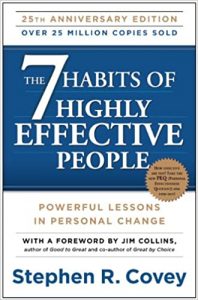 The current (July, 2020) racial tension in the United States has led me to recall one of my favorite productivity lessons: “seek first to understand, then to be understood.” This is Habit 5 from Stephen R. Covey’s bestseller The 7 Habits of Highly Effective People. Since Covey’s book is now 30 years old, I wonder how many millennials have never read the book or learned its timeless lessons?
The current (July, 2020) racial tension in the United States has led me to recall one of my favorite productivity lessons: “seek first to understand, then to be understood.” This is Habit 5 from Stephen R. Covey’s bestseller The 7 Habits of Highly Effective People. Since Covey’s book is now 30 years old, I wonder how many millennials have never read the book or learned its timeless lessons?
Here is a brief summary of the key lessons from the 7 Habits.
Stephen R. Covey – R.I.P.
Habit 1: Be Proactive
Whenever something impacts you, YOU are in control of the response. Effective people choose to take the initiative and act back. The key lesson in Habit 1 is understanding whether you control, influence, or only have concern about an impact. We can ignore areas outside of these three circles as they are of no concern to you.
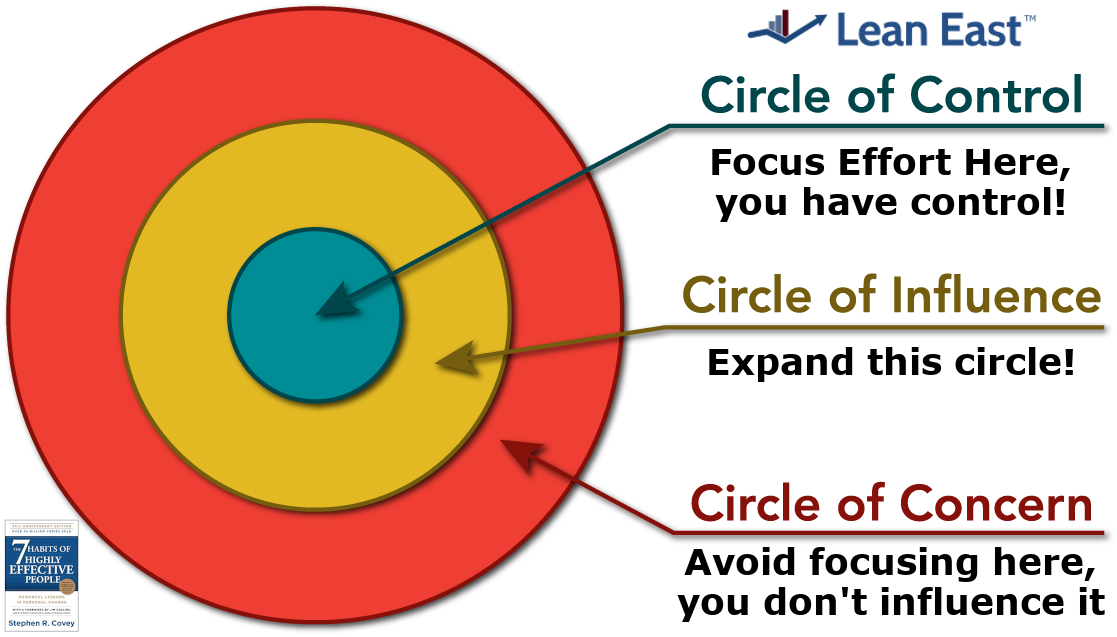
The Three Circles:
The outer circle of concern includes everything that impacts you. Some areas of the outer circle are areas where your choices have a direct impact – this is your circle of influence. The inner circle represents matters you directly control. Productive people exert effort in their Circle of Influence.
Your Circle of Control:
Be proactive in the areas you have direct control over. These areas include:
- Where you live and work
- What you buy, read, listen to, and watch
- If you eat healthy foods and exercise
- The time you go to bed and get up in the morning
Making the best choices won’t always be easy (we will write more about that next month), but you are in charge.
Circle of Influence
Being proactive in your Circle of Influence will help you become more influential, but there will still be areas that you do not fully control:
- Your health
- A job promotion or business success
- Local politics
For example, eating healthy foods and exercising regularly will influence your health, however, it does not mean you will not get sick. Above all, healthy people still get sick. Being nice to someone influences whether they will like you, but it doesn’t guarantee it!
Becoming a more effective person will expand your Circle of Influence. For example, leading the team will give you more influence than if you are a team member!
Circle of Concern (but outside the Circle of Influence)
Avoid the negative energy of focusing on areas that concern you, but you don’t influence. Examples include the weather, the news, and the economy.
Reactive people will often blame or complain about these concerns, however, this wastes time and shrinks their circle of influence.
Habit 2: Begin with the End in Mind
Covey asks us to close our eyes and consider attending a funeral. As you enter the building you are surprised to know everyone in attendance. When you walk to the front of the room and view the casket, you suddenly come face to face with yourself. This is your funeral.
You take a seat and look at the program. There are four speakers: one from your immediate family, one who is a friend, one who has worked with you professionally, and one a prominent member of the community. Now think deeply: what would you like each of the speakers to say about you and your life?
Habit 2 asks us to create the plan for our life.
- What will we accomplish?
- Which roles will we have?
- What goals do we want to achieve?
- What kind of person will we be?
Effective people act based on their principles and Habit 2 is about defining our Principles and Mission. Do this for each role in your life. What do you want your legacy to be?
Habit 3: Put First Things First
This habit is all about time management so that you can be proactive and act according to your principles to achieve your goals.
Covey asks us to consider a Time Management matrix with two variables: urgency and importance. This matrix has four quadrants as shown below:
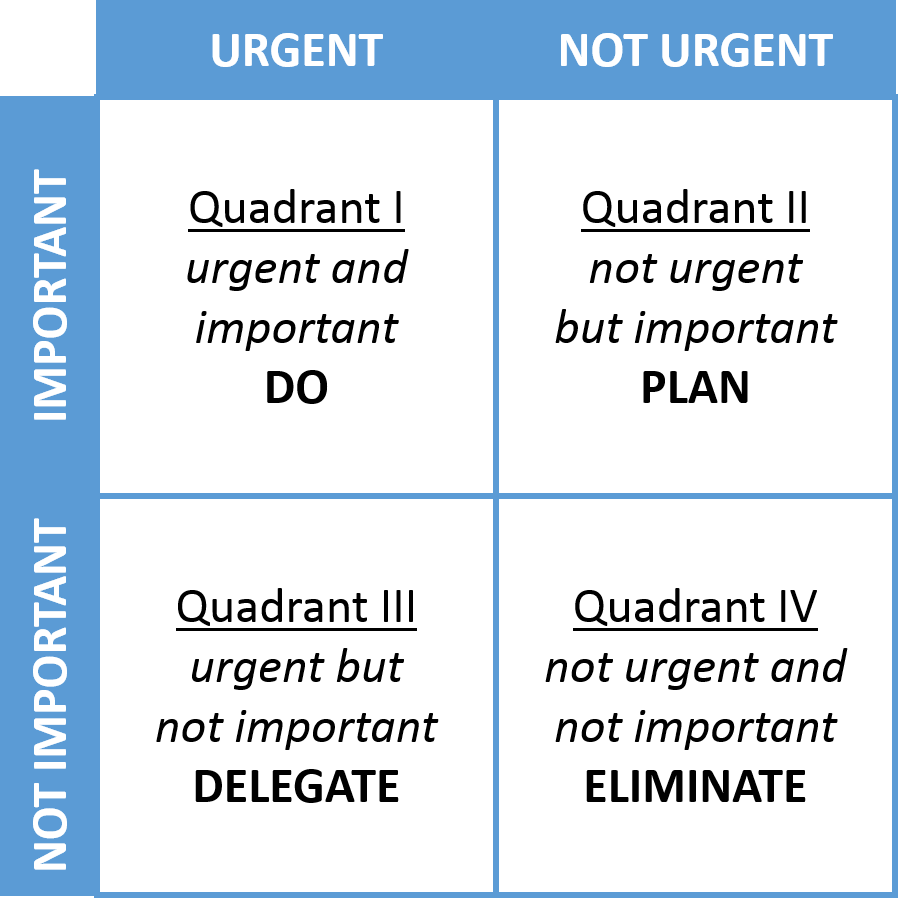
Davidjcmorris / CC BY-SA
Many business leaders we work with have learned to delegate or eliminate the unimportant time spent in Quadrants III and IV. Unfortunately, we see too many leaders who spend all of their time “fighting fires” in Quadrant I.
Habit 3 is really about expanding our time and effort in Quadrant II. These areas include important but not urgent areas such as:
- Visioning
- Planning
- Learning and Growing
- Problem Solving to Root Cause
- Developing others
 When managing your time, schedule your Quadrant II activities first. If we don’t schedule the “big rocks” first we risk our schedule filling up with items from Quadrants I, III, and IV.
When managing your time, schedule your Quadrant II activities first. If we don’t schedule the “big rocks” first we risk our schedule filling up with items from Quadrants I, III, and IV.
Here is another Lean East post about setting Quadrant II goals – Is this the most important success habit?
Also, see this Lean East post that shares a technique for balancing and prioritizing based upon the roles in your personal and professional life.
Private and Public Victories
The first three habits are all internally (independence) focused. Habit 1 is realizing that you are in charge and deciding to act proactively in areas you influence, while Habit 2 is creating the blueprint or program, and Habit 3 is executing the program.
Once you have some understanding and mastery of yourself (the three habits of Private Victory), move on to Habits 4, 5, and 6 of the 7 Habits of Highly Effective People – the three habits of Public Victory.
Habit 4: Think Win-Win
This is the first habit of interdependence – working with others.
Covey teaches that all relationships have an “account balance” we informally keep with family, friends, associates, coworkers, and anyone else we interact with. Emotional bank accounts have deposits and withdrawals just like a regular bank account. Positive interactions are deposits and negative interactions are withdrawals.
Thinking Win-Win is having a frame of mind and heart that constantly seeks mutual benefit in interactions. For example, a “win” for all is a better long-term solution than having one side in a negotiation “lose.”
Win-Win isn’t about being nice or giving in. It requires more effort to understand what constitutes a “win” for each side and structures an agreement to maximize benefits for all. Information about setting up a Win-Win Agreement is shared in the wonderful story, “Green and Clean” about Servant Leadership.
Habit 4 is about approaching every interaction with Win-Win as your objective, while Habit 5 provides a great technique for achieving Win-Win results.
Habit 5: Seek First to Understand, Then to be Understood
The best way to go for Win-Win is to fully understand both sides. Covey recommends we always seek first to understand the other person’s perspective. Using empathic listening to genuinely understand a person compels them to take the same approach with you. As a result, this creates a collegial atmosphere of problem-solving.
The skill of empathic listening involves four developmental stages:
- Mimic content: The first, least effective method is to mimic content. As you listen to the other side simply repeat their words back to them. At this stage, they may feel heard, but not understood.
- Rephrase the content: Repeat the other side’s message back to them but in your own words.
- Reflect feeling: Use the right (feeling) side of your brain to understand the feelings. Repeat these feelings back to the speaker.
- Rephrase the content and reflect feeling: Use your full brain to understand what the speaker is thinking and feeling about the situation. Summarize the comment and feeling you are understanding to check that you truly understand the content.
Here is an example of a response in all four stages, with each stage reflecting a more developed understanding of Habit 5. Imagine an employee approaches you and says,
“I’m so sick of dealing with Jim. He needs to be fired!”
- Mimic content: “You are sick of dealing with Jim and he needs to be fired.”
- Rephrase the content: “You don’t want to work with Jim anymore.”
- Reflect feeling: “You are really frustrated.”
- Rephrase the content and reflect feeling: “Working with Jim is really frustrating you.”
After responding, DO NOT continue to speak. Instead, wait for more information from the employee. Continue to listen with empathy and seek to understand what the employee is feeling.
Habit 5 requires great patience and practice – it is an area I continually need to improve. I have found that, when used, the results of seeking first to understand are well worth it.
Habit 6: Synergize
Synergy is the essence of principle-centered leadership. It means that the whole is greater than the parts.
You should think of synergy as the manifestation of all the habits put together. Proactively bringing a team together to focus on the group’s most important principles and goals. Synergy requires both high trust and high cooperation.
Here is Covey’s illustration of the 7 Habits of Highly Effective People:
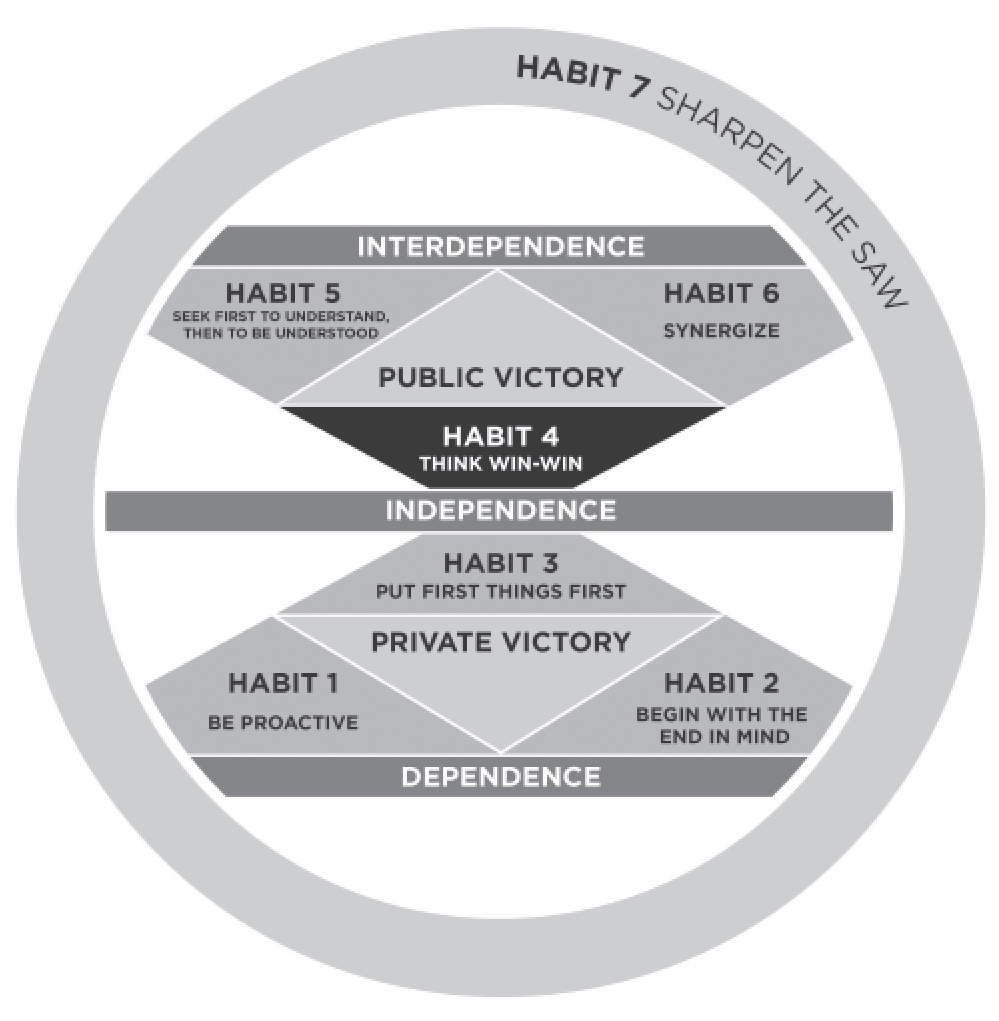
Habit 7: Sharpen the Saw
Lastly, is Habit 7 – the habit of continuous improvement. As Covey puts it:
“Suppose you were to come upon someone in the woods working feverishly to saw down a tree.
“What are you doing?” you ask.
“Can’t you see?” comes the impatient reply. “I’m sawing down this tree.”
“You look exhausted!” you exclaim. “How long have you been at it?”
“Over five hours,” he returns, “and I’m beat! This is hard work.”
‘Well, why don’t you take a break for a few minutes and sharpen that saw?” you inquire. “I’m sure it would go a lot faster.”
“I don’t have time to sharpen the saw,” the man says emphatically. “I’m too busy sawing!”
Habit 7 is about preserving and enhancing your greatest asset – you! This renewal is an “important but not urgent” Quadrant II activity. Covey identifies four dimensions of renewal:
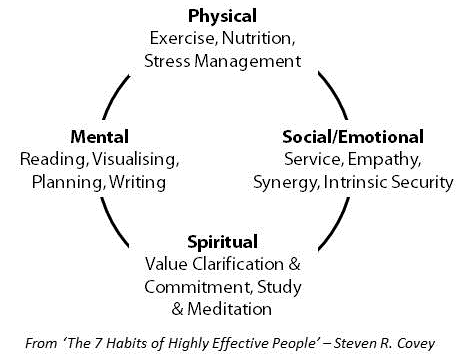
Ensure you prioritize time growing and renewing in each of these four dimensions. Lean East will be happy to encourage and support you in your continuous improvement!
In short, we hope this summary of The 7 Habits of Highly Effective People helps you identify ways to improve. Please share your comments about these ideas and concepts below.

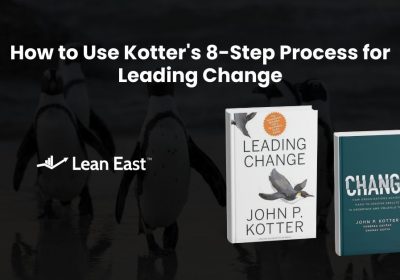
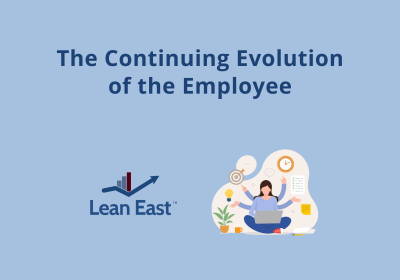
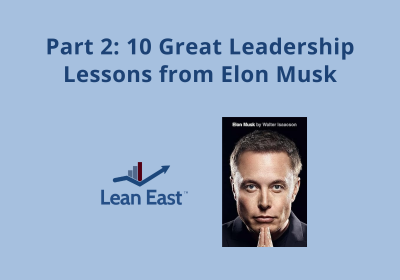
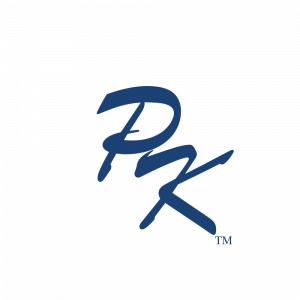

Excellent, Steve. I first read “The Seven Habits” when it first came out, and elements of it were in my training programs all the way through.
I’m thoroughly retired now, but I enjoy reading your stuff when I see it.
Jim Milliken
Good to hear from you, Jim. There are so many ways the lessons of The 7 Habits apply to Project Management. I’m glad you have included those elements in your training.
Be well!